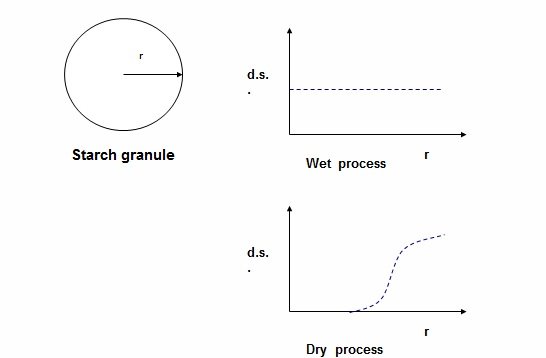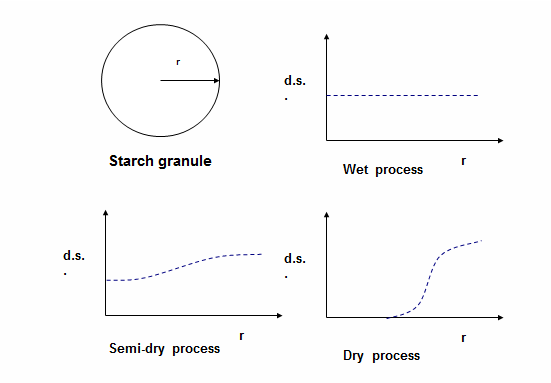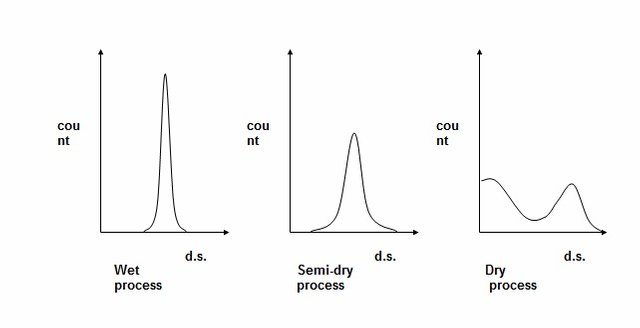Cationic Starch Wet process vs Semi Dry Process
Reactions
Wet process products are made batch-wise, with starch slurries of about 35%.
-Reagents are added and the reaction proceeds under controlled conditions more than 8 hours.- The reaction is then stopped and the product dewatered and dried.
In the dry process, the various reagents are added to dry starch.
This may be either a batch or continuous process
No water is added. There is no drying stage.
DS Profiles

- In the semi-dry process, dry starch is fluidised in a special mixer, to which are added the various reagents in dilute form.
- Water needs to be present to carry the chemicals into the starch granule.
- the process is continuous
- the starch product is dried in line

DS Distribution

Process Advantages
1.Full utilisation of equipment
2.no stop-start of drier
3.continuous process - faster response
- more flexible - shorter runs / bespoke products
- able to produce acidified starches in semi-dry process
- necessary for ASA emulsification.
- Easier to produce high ds starches in semi-dry process
- required for very closed or dirty systems
Benefits
The broader distribution of the semi-dry product is an advantage in complex systems, where there exists a variety of anionic species of differing charge affinities – such as waste paper systems, de-inked furnishes, coated broke, “trashy” pulp.
It appears that the higher d.s fraction is first exhausted by the more aggressive anionic species, leaving much of the remainder to react with with the bulk component i.e. fibre.
Advantages
Semi-dry cationics have a lower pH, keeps cooker jet clean.
Over 80% of ASA systems in the APP are supplied with semi-dry process tapioca starches
Semi-dry process tapioca starches are approved and proven for use on most Asian machines running tropical
hardwood pulp.
Machine Performance
Replacing a wet process process with the equivalent semi-dry product in fine paper machines has resulted in increased flocculation
it was necessary to reduce the starch addition or polymer addition in order to regain formation but with consequent effect on strength or retention respectively.
a lower d.s. starch may be used
semi-dry product seems to have more “grab” for the fibres
Hi! I am a robot. I just upvoted you! I found similar content that readers might be interested in:
https://link.springer.com/chapter/10.1007/978-1-4020-6038-0_9
Hii Robot...this is a knowledge...knowledge about general CATIONIC STARCH...not Native STARCH.. some knowledge is general but another is special, especially Cationic Starch from Semi DRY Process.. in is only technology in Indonesia...
Congratulations @deviasyifak! You have completed some achievement on Steemit and have been rewarded with new badge(s) :
Click on any badge to view your own Board of Honor on SteemitBoard.
For more information about SteemitBoard, click here
If you no longer want to receive notifications, reply to this comment with the word
STOPThank for you review..I am new comer and still need learn from you and others...